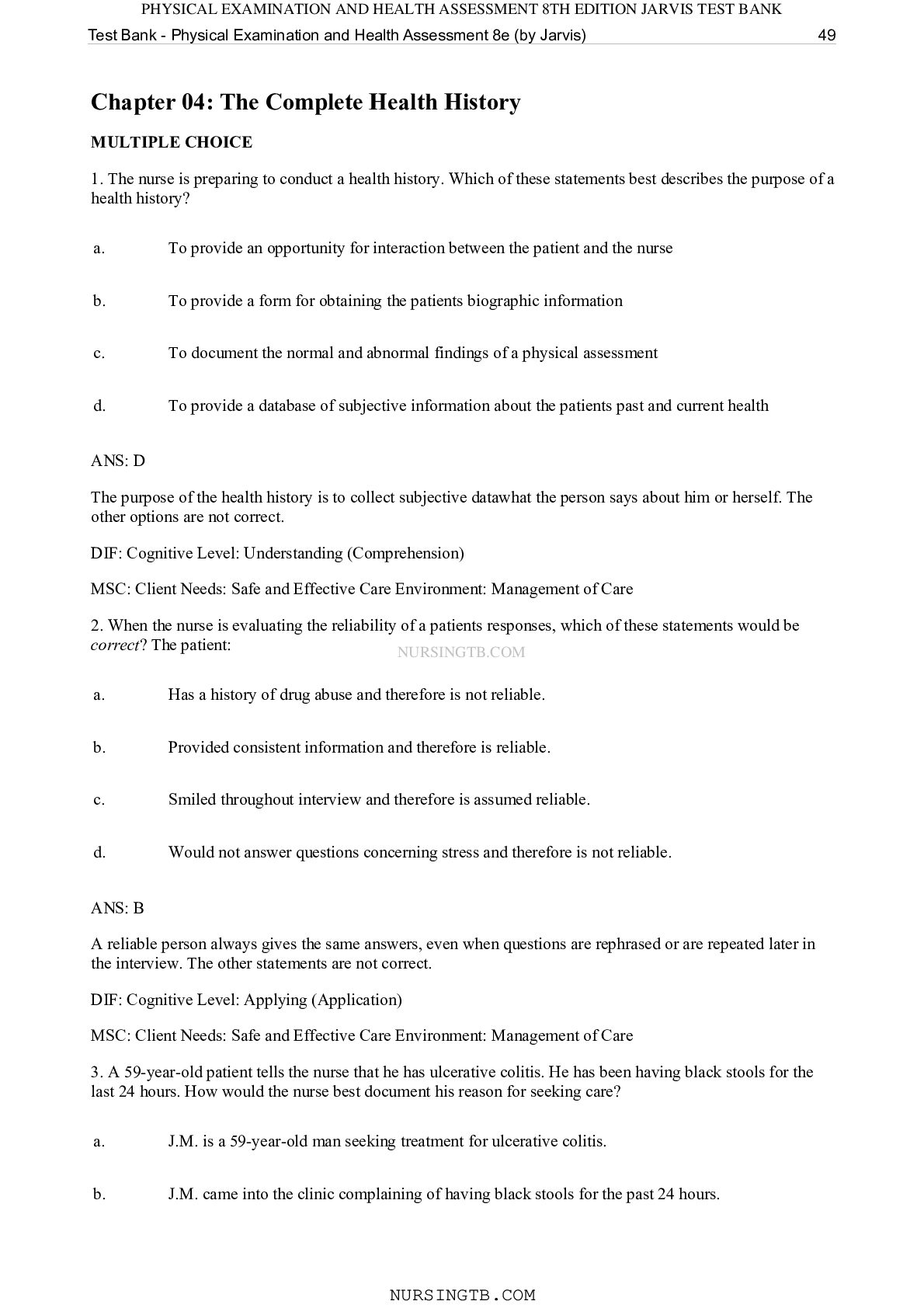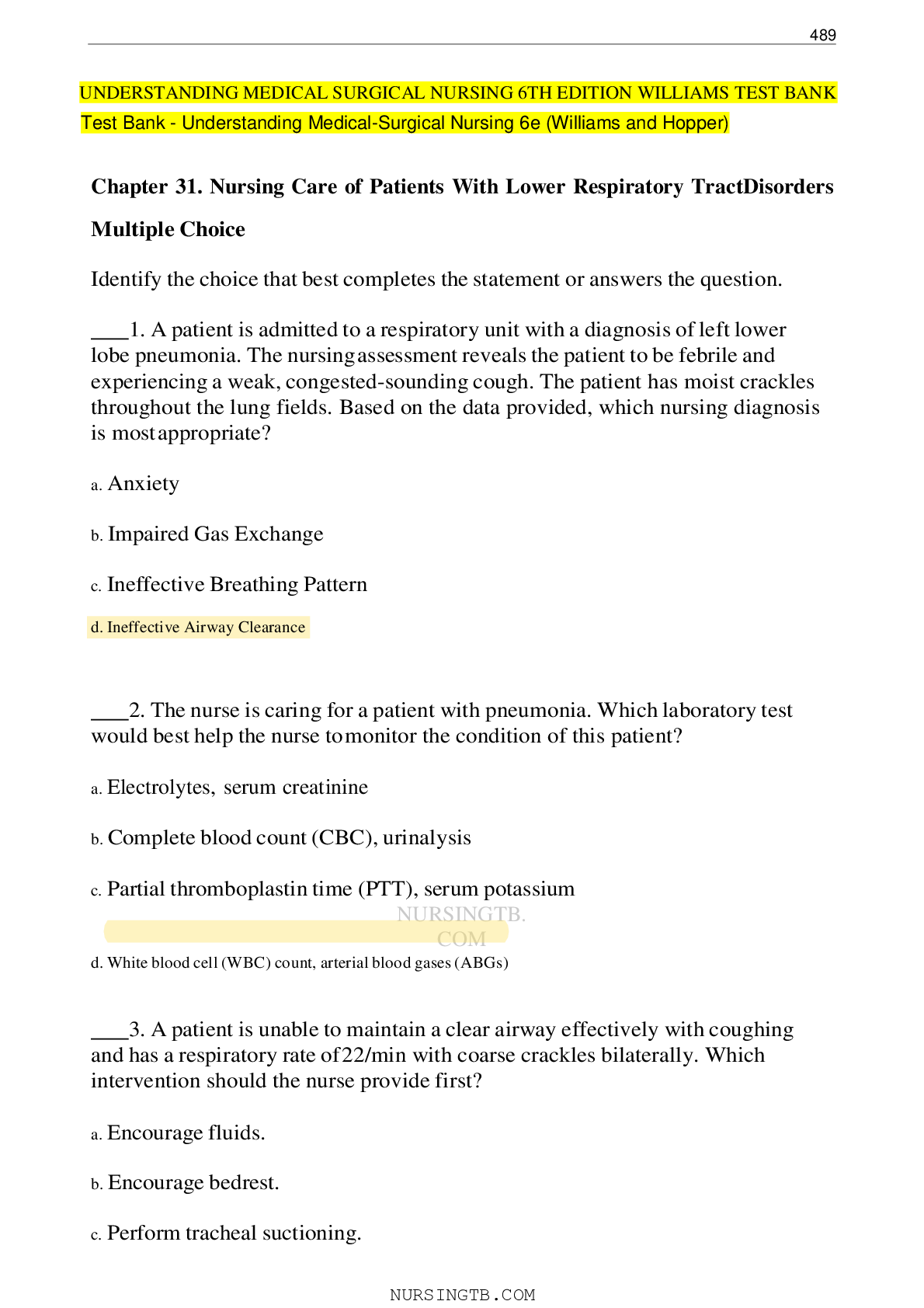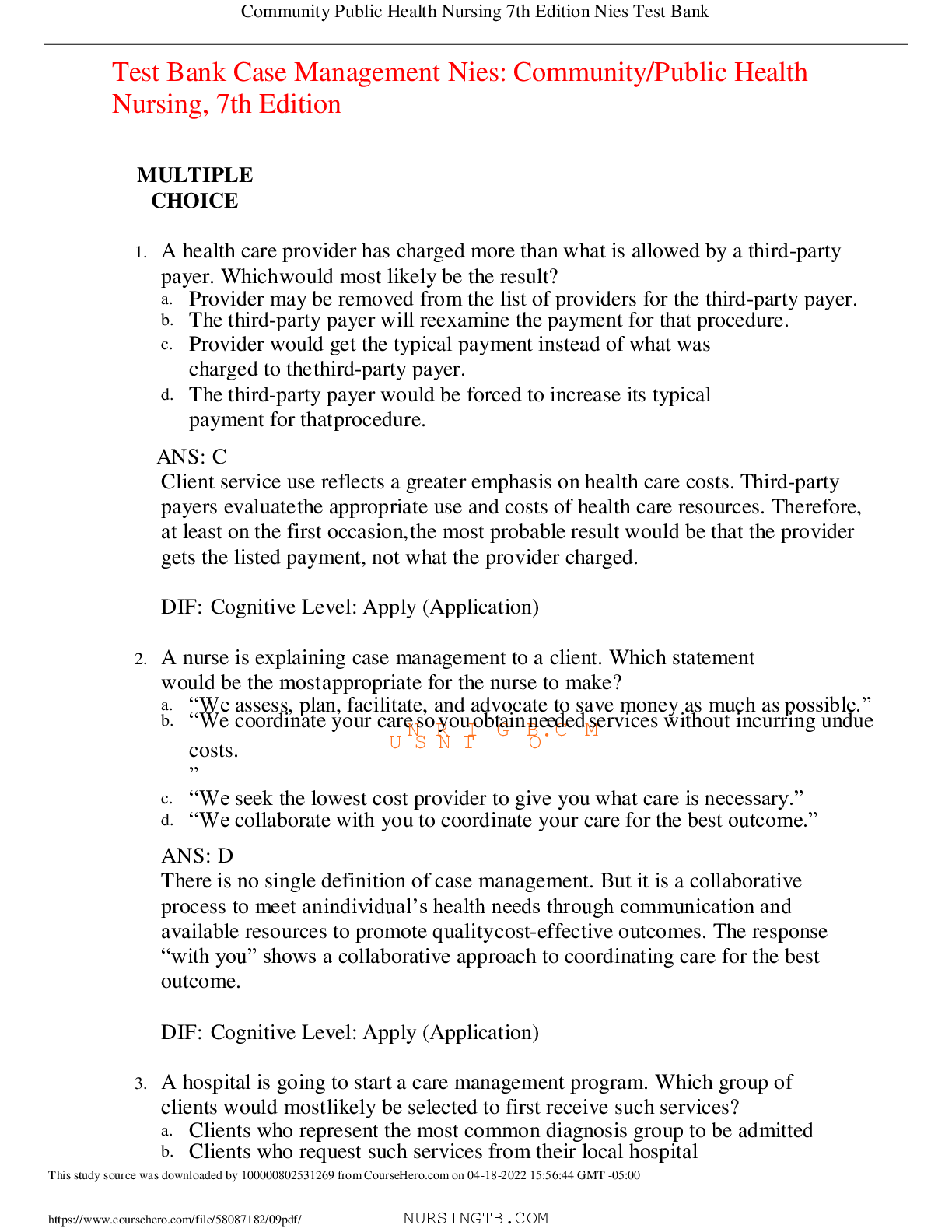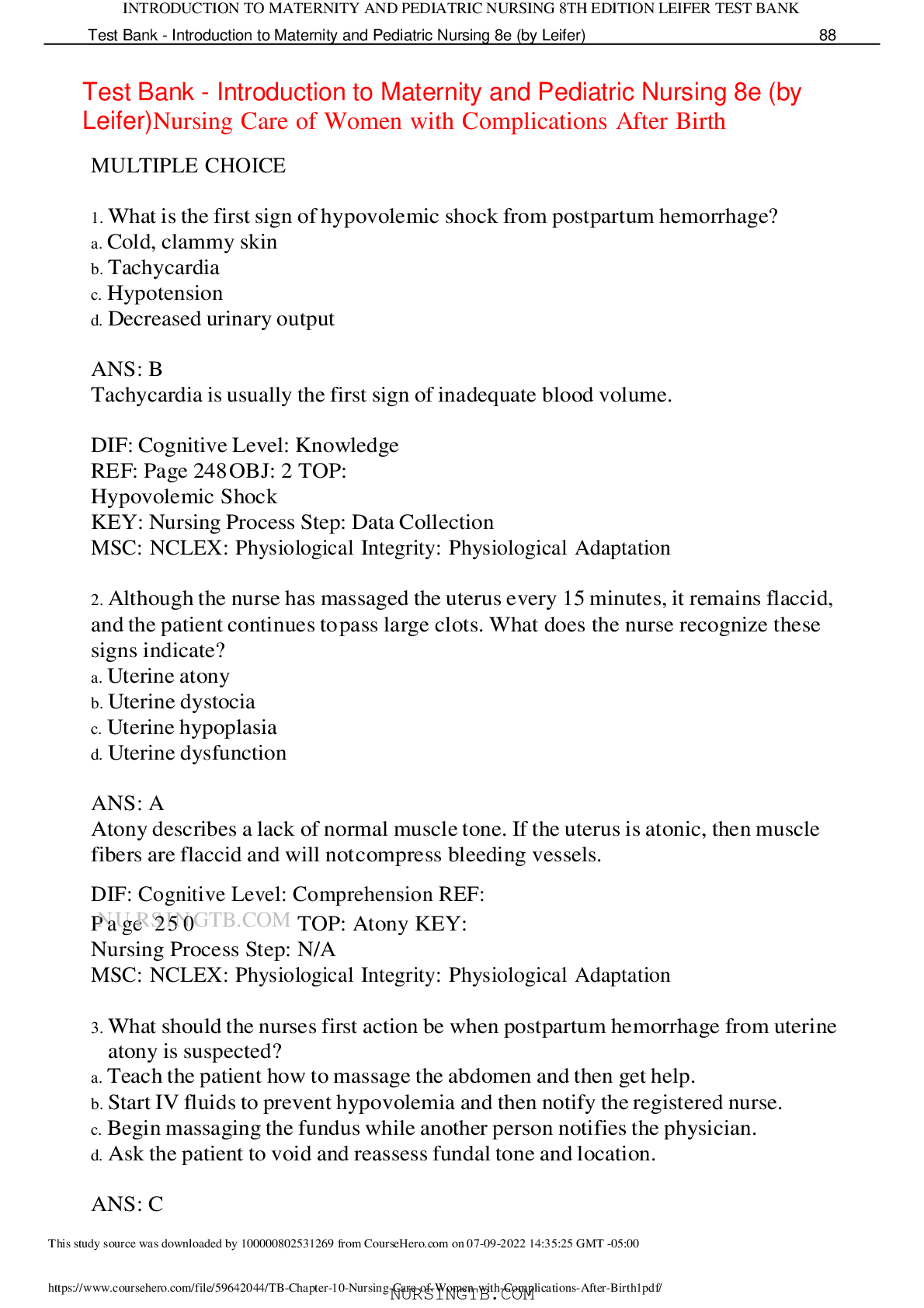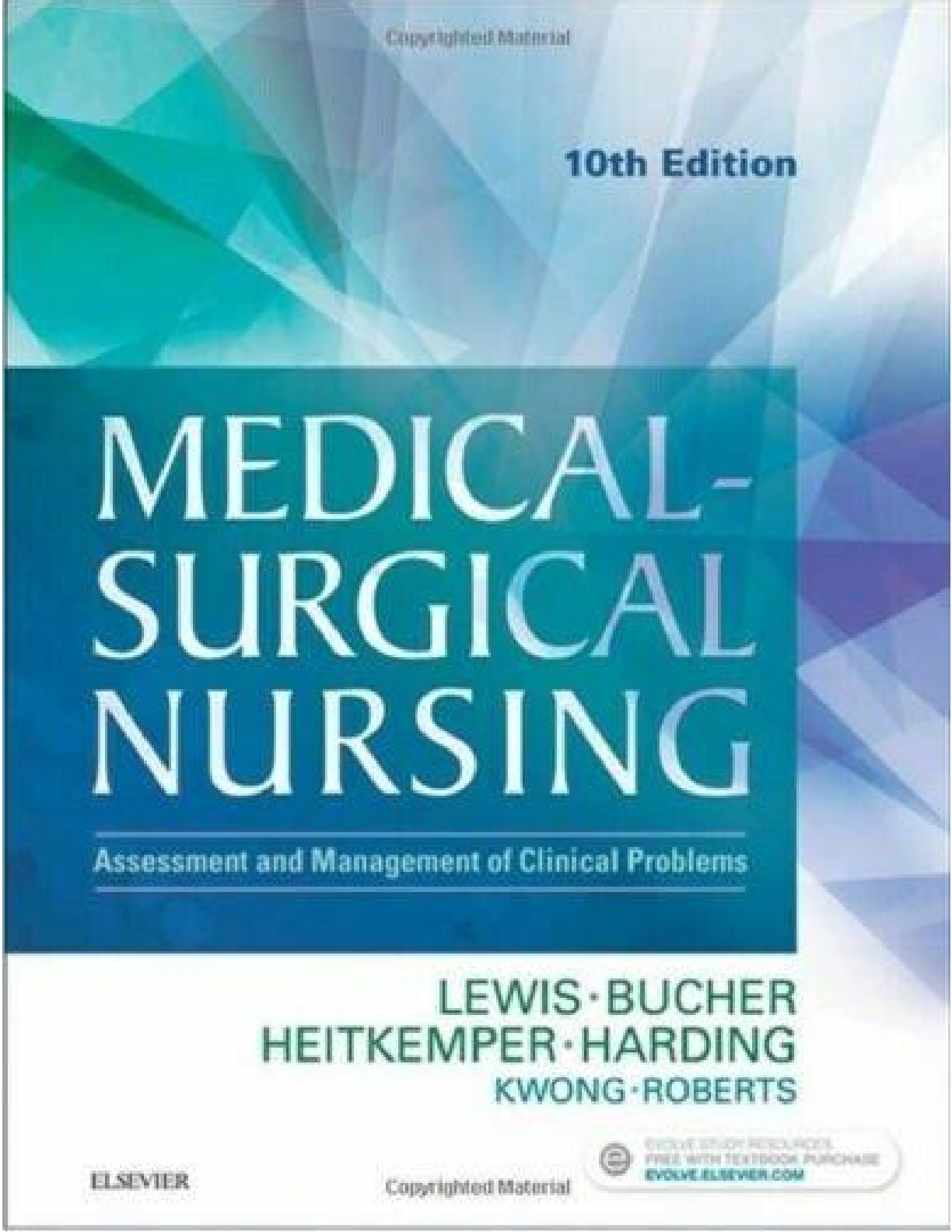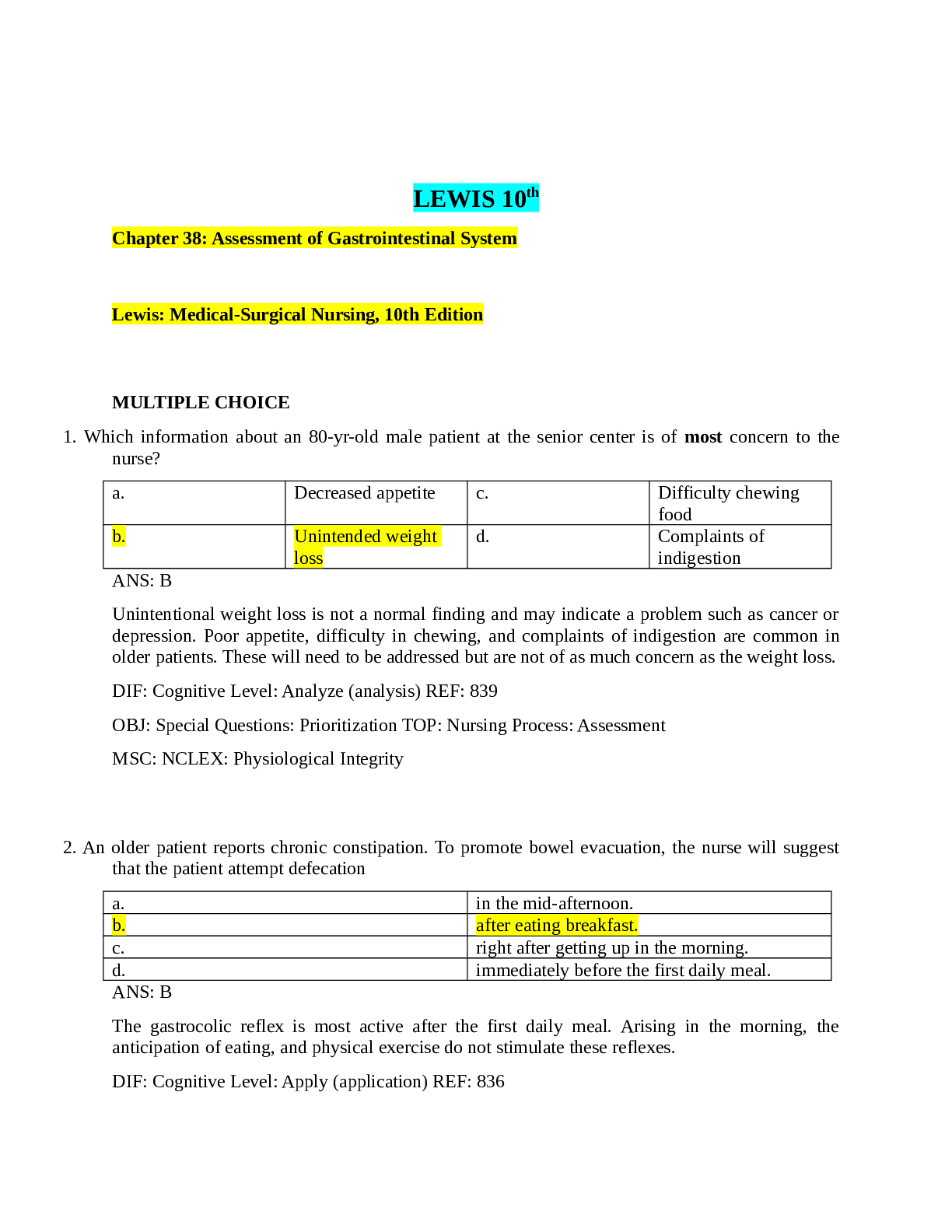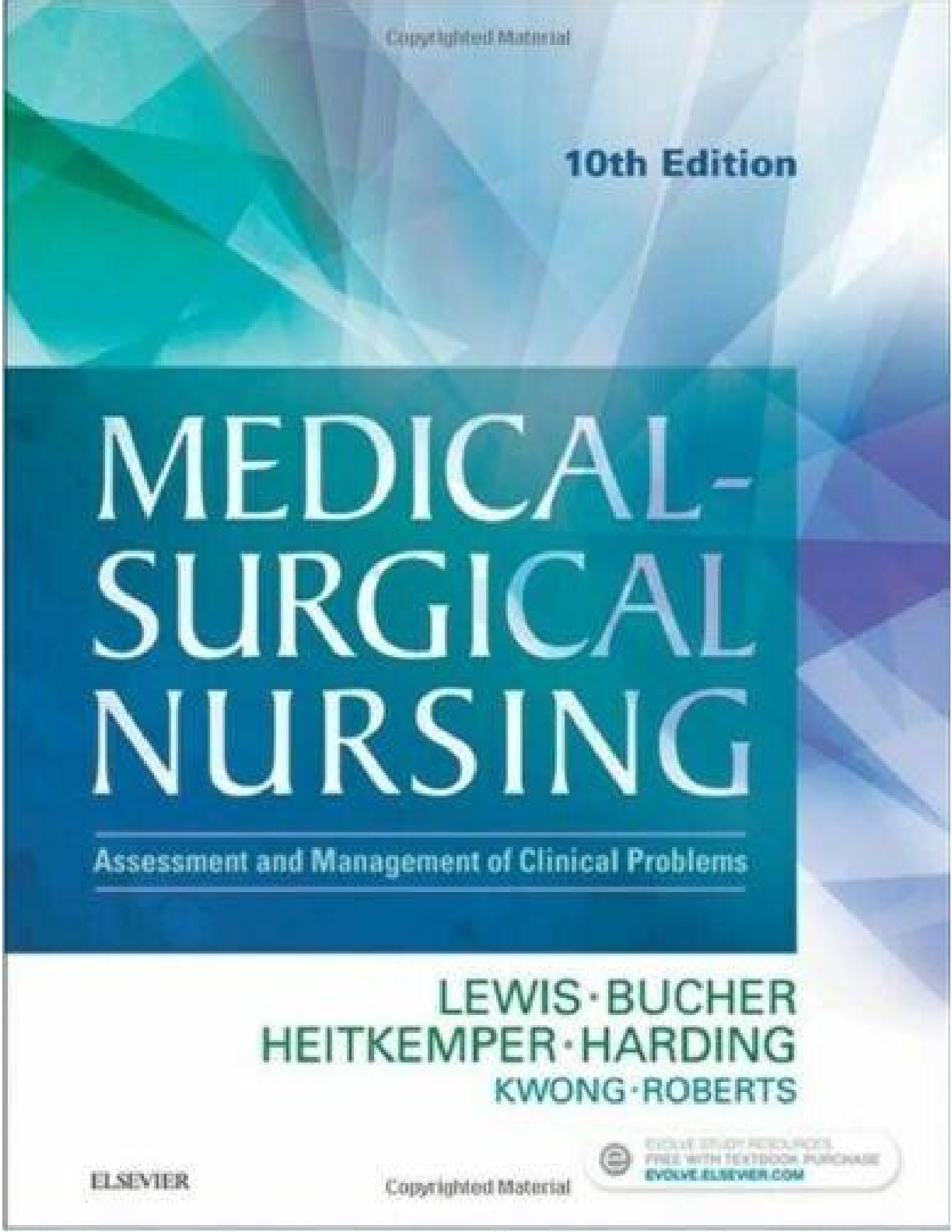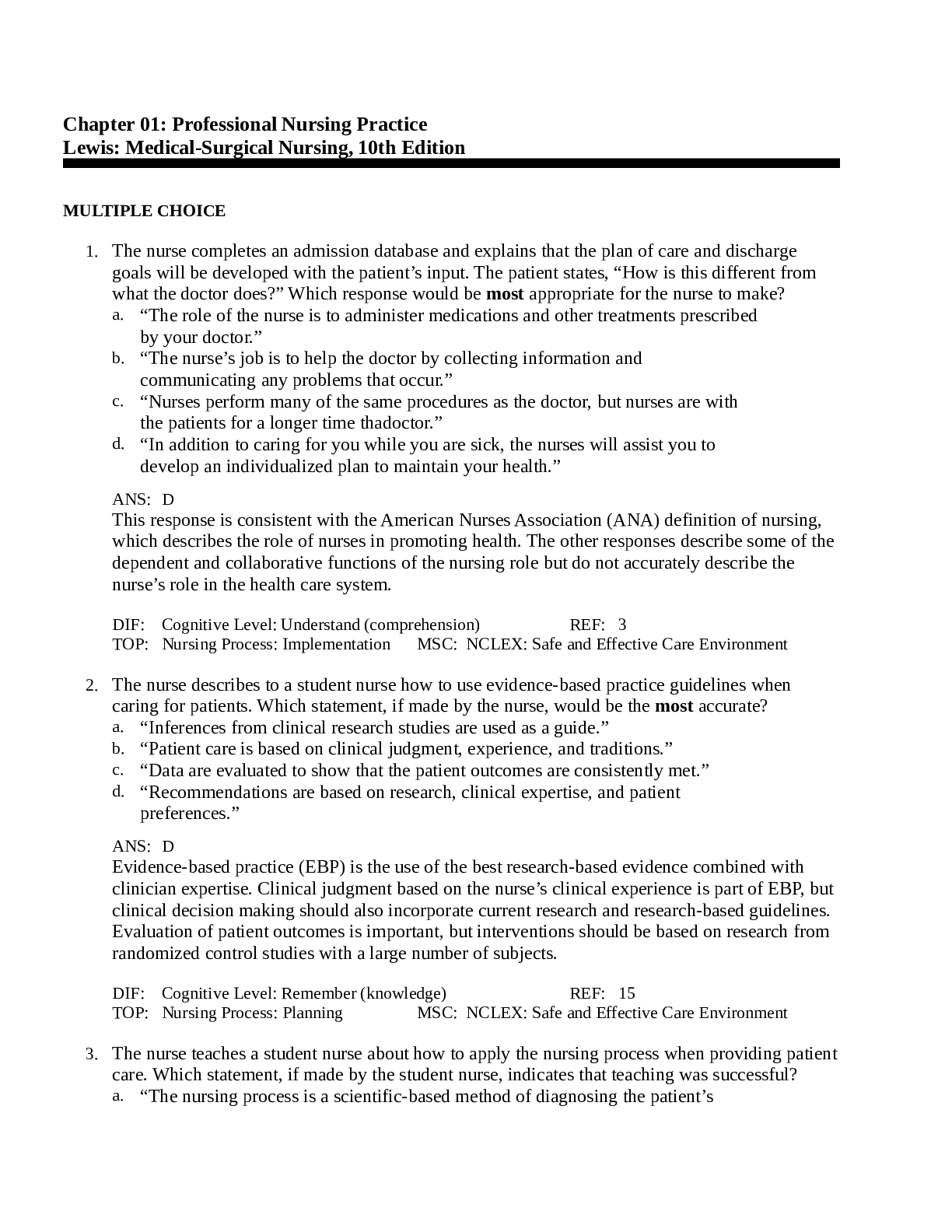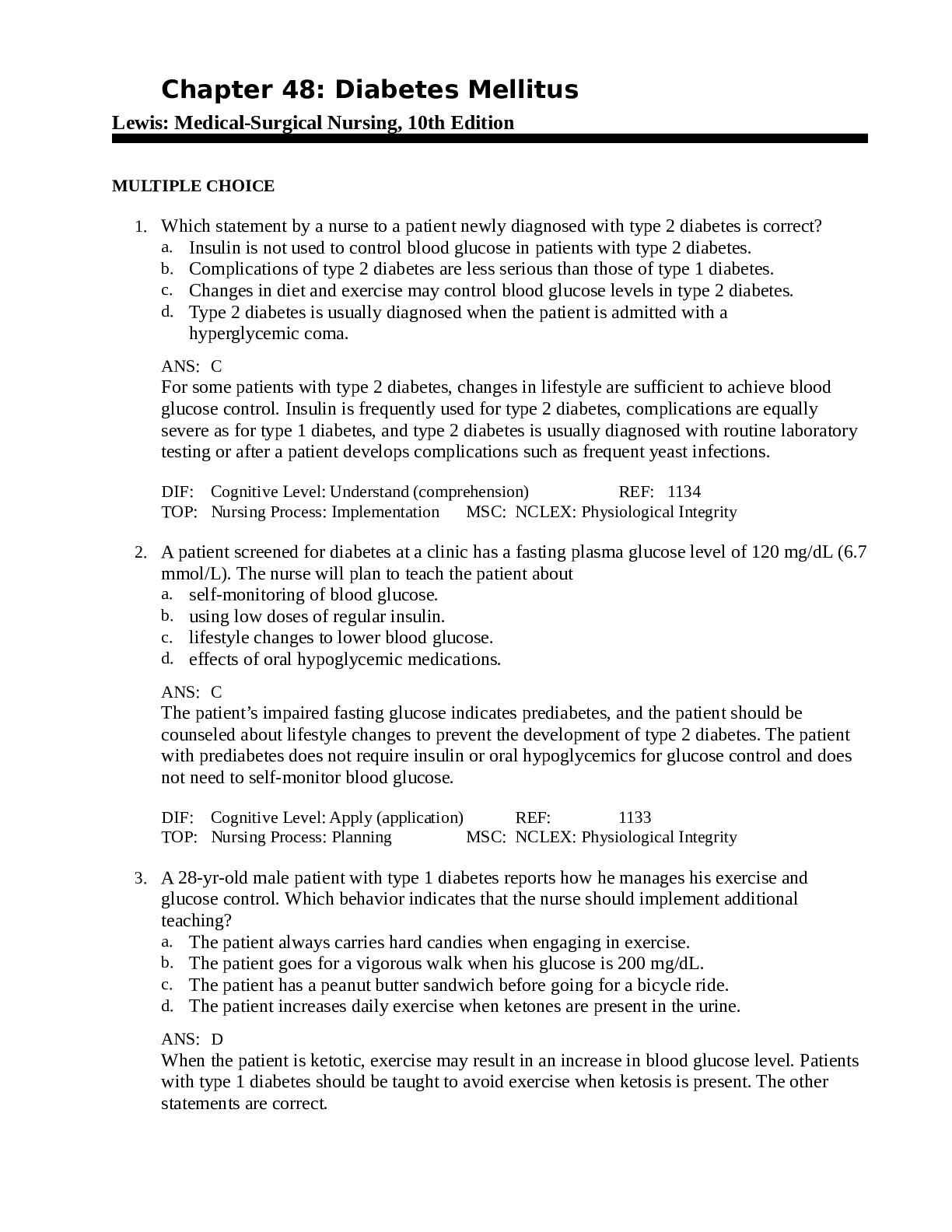*NURSING > TEST BANK > Test Bank Postoperative Care Lewis: Medical-Surgical Nursing, 10th Edition,100% CORRECT (All)
Test Bank Postoperative Care Lewis: Medical-Surgical Nursing, 10th Edition,100% CORRECT
Document Content and Description Below
Test Bank Postoperative Care Lewis: Medical-Surgical Nursing, 10th Edition MULTIPLE CHOICE 1. On admission of a patient to the postanesthesia care unit (PACU), the blood pressure (BP) is 122/7... 2 mm Hg. Thirty minutes after admission, the BP is 114/62, with a pulse of 74 and warm, dry skin. Which action by the nurse is most appropriate? a. Increase the IV fluid rate. b. Notify the anesthesia care provider (ACP). c. Continue to take vital signs every 15 minutes. d. Administer oxygen therapy at 100% per mask. ANS: C A slight drop in postoperative BP with a normal pulse and warm, dry skin indicates normal response to the residual effects of anesthesia and requires only ongoing monitoring. Hypotension with tachycardia or cool, clammy skin would suggest hypovolemic or hemorrhagic shock and the need for notification of the ACP, increased fluids, and high- concentration oxygen administration. DIF: Cognitive Level: Analyze (analysis) REF: 337 TOP: Nursing Process: Implementation MSC: NCLEX: Physiological Integrity 2. In the postanesthesia care unit (PACU), a patient’s vital signs are blood pressure 116/72 mm Hg, pulse 74 beats/min, respirations 12 breaths/min, and SpO2 91%. The patient is sleepy but awakens easily. Which action should the nurse take first? a. Place the patient in a side-lying position. b. Encourage the patient to take deep breaths. c. Prepare to transfer the patient to a clinical unit. d. Increase the rate of the postoperative IV fluids. ANS: B The patient’s borderline SpO2 and sleepiness indicate hypoventilation. The nurse should stimulate the patient and remind the patient to take deep breaths. Placing the patient in a lateral position is needed when the patient first arrives in the PACU and is unconscious. The stable blood pressure and pulse indicate that no changes in fluid intake are required. The patient is not fully awake and has a low SpO2, indicating that transfer from the PACU to a clinical unit is not appropriate. DIF: Cognitive Level: Analyze (analysis) REF: 333 OBJ: Special Questions: Prioritization TOP: Nursing Process: Implementation MSC: NCLEX: Physiological Integrity 3. An experienced nurse orients a new nurse to the postanesthesia care unit (PACU). Which action by the new nurse, if observed by the experienced nurse, indicates that the orientation was successful? a. The new nurse assists a nauseated patient to a supine position. b. The new nurse positions an unconscious patient supine with the head elevated. c. The new nurse positions an unconscious patient on the side upon arrival in the PACU. d. The new nurse places a patient in the Trendelenburg position for a low blood pressure. ANS: C The patient should initially be positioned in the lateral “recovery” position to keep the airway open and avoid aspiration. The Trendelenburg position is avoided because it increases the work of breathing. The patient is placed supine with the head elevated after regaining consciousness. DIF: Cognitive Level: Apply (application) REF: 336 TOP: Nursing Process: Evaluation MSC: NCLEX: Safe and Effective Care Environment 4. An older patient is being discharged from the ambulatory surgical unit following left eye surgery. The patient tells the nurse, “I don’t know if I can take care of myself once I’m home.” Which action by the nurse is most appropriate? a. Provide written instructions for the care. b. Assess the patient’s home support system. c. Discuss specific concerns regarding self-care. d. Refer the patient for home health care services. ANS: C The nurse’s initial action should be to assess exactly the patient’s concerns about self-care. Referral to home health care and assessment of the patient’s support system may be appropriate actions but will be based on further assessment of the patient’s concerns. Written instructions should be given to the patient, but these are unlikely to address the patient’s stated concern about self-care. DIF: Cognitive Level: Analyze (analysis) REF: 344 TOP: Nursing Process: Implementation MSC: NCLEX: Physiological Integrity 5. The nasogastric (NG) tube is removed on the second postoperative day, and the patient is placed on a clear liquid diet. Four hours later, the patient complains of frequent, cramping gas pains. What action by the nurse is the most appropriate? a. Reinsert the NG tube. c. Assist the patient to ambulate. b. Give the PRN IV opioid. d. Place the patient on NPO status. ANS: C Ambulation encourages peristalsis and the passing of flatus, which will relieve the patient’s discomfort. If distention persists, the patient may need to be placed on NPO status, but usually this is not necessary. Morphine administration will further decrease intestinal motility. Gas pains are usually caused by trapping of flatus in the colon, and reinsertion of the NG tube will not relieve the pains. DIF: Cognitive Level: Analyze (analysis) REF: 342 TOP: Nursing Process: Implementation MSC: NCLEX: Physiological Integrity 6. A patient’s T-tube is draining dark green fluid after gallbladder surgery. What action by the nurse is the most appropriate? a. Notify the patient’s surgeon. b. Place the patient on bed rest. c. Document the color and amount of drainage. d. Irrigate the T-tube with sterile normal saline. ANS: C A T-tube normally drains dark green to bright yellow drainage so no action other than to document the amount and color of the drainage is needed. The other actions are not necessary. DIF: Cognitive Level: Apply (application) REF: 344 TOP: Nursing Process: Implementation MSC: NCLEX: Physiological Integrity 7. Which action by the nurse will be most helpful to a patient who is expected to ambulate, deep breathe, and cough on the first postoperative day? a. Schedule the activity to begin after the patient has taken a nap. b. Administer prescribed analgesic medications before the activities. c. Ask the patient to state two possible complications of immobility. d. Encourage the patient to state the purpose of splinting the incision. ANS: B An important nursing action to encourage these postoperative activities is administration of adequate analgesia to allow the patient to accomplish the activities with minimal pain. Even with motivation provided by proper teaching, positive reinforcement, concern about complications, and with rest and sleep, patients will have difficulty if there is a great deal of pain involved with these activities. DIF: Cognitive Level: Analyze (analysis) REF: 340 TOP: Nursing Process: Planning MSC: NCLEX: Physiological Integrity 8. A postoperative patient has a nursing diagnosis of ineffective airway clearance. The nurse determines that interventions for this nursing diagnosis have been successful if which is observed? a. Patient drinks 2 to 3 L of fluid in 24 hours. b. Patient uses the spirometer 10 times every hour. c. Patient’s breath sounds are clear to auscultation. d. Patient’s temperature is less than 100.2°F orally. ANS: C One characteristic of ineffective airway clearance is the presence of adventitious breath sounds such as crackles, so clear breath sounds are an indication of resolution of the problem. Spirometer use and increased fluid intake are interventions for ineffective airway clearance but may not always improve breath sounds. Elevated temperature may occur with atelectasis, but a normal or near-normal temperature does not always indicate resolution of respiratory problems. DIF: Cognitive Level: Apply (application) REF: 331 TOP: Nursing Process: Evaluation MSC: NCLEX: Physiological Integrity 9. A patient who has begun to awaken after 30 minutes in the postanesthesia care unit (PACU) is restless and shouting at the nurse. The patient’s oxygen saturation is 96%, and recent laboratory results are all normal. Which action by the nurse is most appropriate? a. Increase the IV fluid rate. b. Assess for bladder distention. c. Notify the anesthesia care provider (ACP). d. Demonstrate the use of the nurse call bell button. ANS: B Because the patient’s assessment indicates physiologic stability, the most likely cause of the patient’s agitation is emergence delirium, which will resolve as the patient wakes up more fully. The nurse should look for a cause such as bladder distention. Although hypoxemia is the most common cause, the patient’s oxygen saturation is 96%. Emergence delirium is common in patients recovering from anesthesia, so there is no need to notify the ACP. Orientation of the patient to bed controls is needed but is not likely to be effective until the effects of anesthesia have resolved more completely. DIF: Cognitive Level: Analyze (analysis) REF: 337 TOP: Nursing Process: Implementation MSC: NCLEX: Physiological Integrity 10. Which action could the postanesthesia care unit (PACU) nurse delegate to unlicensed assistive personnel (UAP) who help to transport a patient to the clinical unit? a. Clarify the postoperative orders with the surgeon. b. Help with the transfer of the patient onto a stretcher. c. Document the appearance of the patient’s incision in the chart. d. Provide hand off communication to the surgical unit charge nurse. ANS: B The scope of practice of UAP includes repositioning and moving patients under the supervision of a nurse. Providing report to another nurse, assessing and documenting the wound appearance, and clarifying physician orders with another nurse require registered-nurse (RN) level education and scope of practice. DIF: Cognitive Level: Apply (application) REF: 334 OBJ: Special Questions: Delegation TOP: Nursing Process: Planning MSC: NCLEX: Safe and Effective Care Environment 11. A patient is transferred from the postanesthesia care unit (PACU) to the clinical unit. Which action by the nurse on the clinical unit should be performed first? a. Assess the patient’s pain. c. Take the patient’s vital signs. b. Orient the patient to the unit. d. Read the postoperative orders. ANS: C Because the priority concerns after surgery are airway, breathing, and circulation, the vital signs are assessed first. The other actions should take place after the vital signs are obtained and compared with the vital signs before transfer. DIF: Cognitive Level: Analyze (analysis) REF: 337 OBJ: Special Questions: Prioritization TOP: Nursing Process: Implementation MSC: NCLEX: Physiological Integrity 12. An older patient who had knee replacement surgery 2 days ago can only tolerate being out of bed with physical therapy twice a day. Which collaborative problem should the nurse identify as a priority for this patient? a. Potential complication: hypovolemic shock b. Potential complication: venous thromboembolism c. Potential complication: fluid and electrolyte imbalance d. Potential complication: impaired surgical wound healing ANS: B The patient is older and relatively immobile, which are two risk factors for development of deep vein thrombosis. The other potential complications are possible postoperative problems, but they are not at a high risk based on the data about this patient. DIF: Cognitive Level: Analyze (analysis) REF: 337 OBJ: Special Questions: Prioritization TOP: Nursing Process: Diagnosis MSC: NCLEX: Physiological Integrity 13. A patient who is just waking up after having hip replacement surgery is agitated and confused. Which action should the nurse take first? a. Administer the prescribed opioid. b. Check the oxygen (O2) saturation. c. Take the blood pressure and pulse. d. Apply wrist restraints to secure IV lines. ANS: B Emergence delirium may be caused by a variety of factors. However, the nurse should first assess for hypoxemia. The other actions also may be appropriate, but are not the best initial action. DIF: Cognitive Level: Analyze (analysis) REF: 338 OBJ: Special Questions: Prioritization TOP: Nursing Process: Implementation MSC: NCLEX: Physiological Integrity 14. A postoperative patient has not voided for 8 hours after return to the clinical unit. Which action should the nurse take first? a. Perform a bladder scan. b. Insert a straight catheter. c. Encourage increased oral fluid intake. d. Assist the patient to ambulate to the bathroom. ANS: A The initial action should be to assess the bladder for distention. If the bladder is distended, providing the patient with privacy (by walking with the patient to the bathroom) will be helpful. Because of the risk for urinary tract infection, catheterization should only be done after other measures have been tried without success. There is no indication to notify the surgeon about this common postoperative problem unless all measures to empty the bladder are unsuccessful. DIF: Cognitive Level: Analyze (analysis) REF: 341 OBJ: Special Questions: Prioritization TOP: Nursing Process: Implementation MSC: NCLEX: Physiological Integrity 15. The nurse is caring for a patient the first postoperative day following a laparotomy for a small bowel obstruction. The nurse notices new bright-red drainage about 5 cm in diameter on the dressing. Which action should the nurse take first? a. Reinforce the dressing. c. Take the patient’s vital signs. b. Apply an abdominal binder. d. Recheck the dressing in 1 hour. ANS: C New bright-red drainage may indicate hemorrhage, and the nurse should initially assess the patient’s vital signs for tachycardia and hypotension. The surgeon should then be notified of the drainage and the vital signs. The dressing may be changed or reinforced, based on the surgeon’s orders or agency policy. The nurse should not wait an hour to recheck the dressing. DIF: Cognitive Level: Analyze (analysis) REF: 337 OBJ: Special Questions: Prioritization TOP: Nursing Process: Implementation MSC: NCLEX: Physiological Integrity 16. When caring for a patient the second postoperative day after abdominal surgery for removal of a large pancreatic cyst, the nurse obtains an oral temperature of 100.8° F (38.2° C). Which action should the nurse take next? a. Place ice packs in the patient’s axillae. b. Have the patient use the incentive spirometer. c. Request an order for acetaminophen (Tylenol). d. Ask the health care provider to prescribe a different antibiotic. ANS: B A temperature of 100.8° F (38.2° C) in the first 48 hours is usually caused by atelectasis, and the nurse should have the patient deep breathe, cough, and use the incentive spirometer. This problem may be resolved by nursing intervention, and therefore notifying the health care provider is not necessary. Acetaminophen or ice packs will reduce the temperature, but it will not resolve the underlying respiratory congestion. DIF: Cognitive Level: Apply (application) REF: 334 OBJ: Special Questions: Prioritization TOP: Nursing Process: Implementation MSC: NCLEX: Physiological Integrity 17. The nurse assesses that the oxygen saturation is 89% in an unconscious patient who was transferred from surgery to the postanesthesia care unit (PACU) 15 minutes ago. Which action should the nurse take first? a. Suction the patient’s mouth. b. Increase the oxygen flow rate. c. Perform the jaw-thrust maneuver. d. Elevate the patient’s head on two pillows. ANS: C In an unconscious postoperative patient, a likely cause of hypoxemia is airway obstruction by the tongue, and the first action is to clear the airway by maneuvers such as the jaw thrust or chin lift. Increasing the oxygen flow rate and suctioning are not helpful when the airway is obstructed by the tongue. Elevating the patient’s head will not be effective in correcting the obstruction but may help with oxygenation after the patient is awake. DIF: Cognitive Level: Analyze (analysis) REF: 333 OBJ: Special Questions: Prioritization TOP: Nursing Process: Implementation MSC: NCLEX: Physiological Integrity 18. The nurse assesses a patient who had a total abdominal hysterectomy 2 days ago. Which information about the patient is most important to communicate to the health care provider? a. The patient’s temperature is 100.3° F (37.9° C). b. The patient’s calf is swollen, warm, and painful. c. The 24-hour oral intake is 600 mL greater than the total output. d. The patient reports abdominal pain at level 6 (0 to 10 scale) when ambulating. ANS: B The calf pain, swelling, and warmth suggest that the patient has a venous thromboembolism (VTE). This will require the health care provider to order diagnostic tests, anticoagulants, or both and is most critical because a VTE could result in a pulmonary embolism. Because the stress response causes fluid retention for the first 2 to 5 days postoperatively, the difference between intake and output is expected. A temperature elevation to 100.3° F on the second postoperative day is suggestive of atelectasis and the nurse should have the patient deep breathe and cough. Pain with ambulation is normal, and the nurse should administer the ordered analgesic before patient activities. DIF: Cognitive Level: Analyze (analysis) REF: 337 OBJ: Special Questions: Prioritization TOP: Nursing Process: Assessment MSC: NCLEX: Physiological Integrity 19. A patient who had knee surgery received IV ketorolac 30 minutes ago and continues to complain of pain at a level of 7 (0 to 10 scale). Which action is most effective for the nurse to take at this time? a. Administer the prescribed PRN IV morphine sulfate. b. Notify the health care provider about the ongoing pain. c. Reassure the patient that postoperative pain is expected after knee surgery. d. Teach the patient that the effects of ketorolac typically last about 6 to 8 hours. ANS: A The priority at this time is pain relief. Concomitant use of opioids and nonsteroidal antiinflammatory drugs improves pain control in postoperative patients. Patient teaching and reassurance are appropriate but should be done after the patient’s pain is relieved. If the patient continues to have pain after the morphine is administered, the health care provider should be notified. DIF: Cognitive Level: Analyze (analysis) REF: 339 OBJ: Special Questions: Prioritization TOP: Nursing Process: Implementation MSC: NCLEX: Safe and Effective Care Environment 20. The nurse working in the postanesthesia care unit (PACU) notes that a patient who has just been transported from the operating room is shivering and has a temperature of 96.5° F (35.8° C). Which action should the nurse take next? a. Notify the anesthesia care provider. b. Cover the patient with a warm blanket. c. Avoid giving opioid analgesics until the patient is warmer. d. Give acetaminophen (Tylenol) 650 mg suppository rectally. ANS: B The patient assessment indicates the need for active rewarming. There is no indication of a need for acetaminophen. Opioid analgesics may help reduce shivering. Because hypothermia is common in the immediate postoperative period, there is no need to notify the anesthesia care provider unless the patient continues to be hypothermic after active rewarming. DIF: Cognitive Level: Apply (application) REF: 338 TOP: Nursing Process: Implementation MSC: NCLEX: Physiological Integrity 21. Which finding would indicate to the nurse that a postoperative patient is at increased risk for poor wound healing? a. Potassium 3.5 mEq/L c. Hemoglobin 10.2 g/dL b. Albumin level 2.2 g/dL d. White blood cells 11,900/µL ANS: B Because proteins are needed for an appropriate inflammatory response and wound healing, the low serum albumin level (normal level, 3.5 to 5.0 g/dL) indicates a risk for poor wound healing. The potassium level is normal. Because a small amount of blood loss is expected with surgery, the hemoglobin level is not indicative of an increased risk for wound healing. WBC count is expected to increase after surgery as a part of the normal inflammatory response. DIF: Cognitive Level: Apply (application) REF: 343 TOP: Nursing Process: Assessment MSC: NCLEX: Physiological Integrity 22. The nurse assesses a patient on the second postoperative day after abdominal surgery to repair a perforated duodenal ulcer. Which finding is most important for the nurse to report to the surgeon? a. Tympanic temperature 99.2° F (37.3° C) b. Fine crackles audible at both lung bases c. Redness and swelling along the suture line d. 200 mL sanguineous fluid in the wound drain ANS: D Wound drainage should decrease and change in color from sanguineous to serosanguineous by the second postoperative day. The color and amount of drainage for this patient are abnormal and should be reported. Redness and swelling along the suture line and a slightly elevated temperature are normal signs of postoperative inflammation. Atelectasis is common after surgery. The nurse should have the patient cough and deep breathe, but there is no urgent need to notify the surgeon. DIF: Cognitive Level: Analyze (analysis) REF: 343 OBJ: Special Questions: Prioritization TOP: Nursing Process: Assessment MSC: NCLEX: Safe and Effective Care Environment 23. After receiving change-of-shift report about these postoperative patients, which patient should the nurse assess first? a. Obese patient who had abdominal surgery 3 days ago and whose wound edges are separating b. Patient who has 30 mL of sanguineous drainage in the wound drain 10 hours after hip replacement surgery c. Patient who has bibasilar crackles and a temperature of 100° F (37.8 °C) on the first postoperative day after chest surgery d. Patient who continues to have incisional pain 15 minutes after hydrocodone and acetaminophen (Vicodin) was given ANS: A The patient’s history and assessment suggests possible wound dehiscence, which should be reported immediately to the surgeon. Although the information about the other patients indicates a need for ongoing assessment and possible intervention, the data do not suggest any acute complications. Small amounts of red drainage are common in the first postoperative hours. Bibasilar crackles and a slightly elevated temperature are common after surgery, although the nurse will need to have the patient deep breathe and cough. Oral medications typically take more than 15 minutes for effective pain relief. DIF: Cognitive Level: Analyze (analysis) REF: 343 OBJ: Special Questions: Prioritization | Special Questions: Multiple Patients TOP: Nursing Process: Assessment MSC: NCLEX: Safe and Effective Care Environment OTHER 1. While ambulating in the room, a patient complains of feeling dizzy. In what order will the nurse accomplish the following activities? (Put a comma and a space between each answer choice [A, B, C, D].) a. Have the patient sit down in a chair. b. Give the patient something to drink. c. Take the patient’s blood pressure (BP). d. Inform the patient’s health care provider. ANS: A, C, B, D The first priority for the patient with syncope is to prevent a fall, so the patient should be assisted to a chair. Assessment of the BP will determine whether the dizziness is due to orthostatic hypotension, which occurs because of hypovolemia. Increasing the fluid intake will help prevent orthostatic dizziness. Because this is a common postoperative problem that is usually resolved through nursing measures such as increasing fluid intake and making position changes more slowly, there is no urgent need to inform the health care provider. DIF: Cognitive Level: Analyze (analysis) REF: 338 OBJ: Special Questions: Prioritization TOP: Nursing Process: Implementation MSC: NCLEX: Physiological Integrity 2. A patient’s blood pressure in the postanesthesia care unit (PACU) has dropped from an admission blood pressure of 140/86 to 102/60 mm Hg with a pulse change of 70 to 96 beats/min. SpO2 is 92% on 3 L of oxygen. In which order should the nurse take these actions? (Put a comma and a space between each answer choice [A, B, C, D].) a. Increase the IV infusion rate. b. Assess the patient’s dressing. c. Increase the oxygen flow rate. d. Check the patient’s temperature. ANS: A, C, B, D The first nursing action should be to increase the IV infusion rate. Because the most common cause of hypotension is volume loss, the IV rate should be increased. The next action should be to increase the oxygen flow rate to maximize oxygenation of hypoperfused organs. Because hemorrhage is a common cause of postoperative volume loss, the nurse should check the dressing. Finally, the patient’s temperature should be assessed to determine the effects of vasodilation caused by rewarming. DIF: Cognitive Level: Analyze (analysis) REF: 338 OBJ: Special Questions: Prioritization TOP: Nursing Process: Implementation MSC: NCLEX: Physiological Integrity [Show More]
Last updated: 11 months ago
Preview 1 out of 19 pages

Reviews( 0 )
Document information
Connected school, study & course
About the document
Uploaded On
Oct 06, 2022
Number of pages
19
Written in
Additional information
This document has been written for:
Uploaded
Oct 06, 2022
Downloads
0
Views
33

